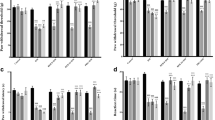Abstract
The role of opioid receptors in diabetes and hyperglycemia-induced analgesia was studied in male Sprague-Dawley rats. Animals maintained under controlled environmental conditions were used in all studies. Pain latency was determined by the hot plate test (55° C) and analgesy-meter force method. The results of these studies indicate that streptozotocin-induced diabetic animals have a significantly higher pain threshold (P<0.01) than the control groups. The pain threshold was found to be diurnally controlled with a peak at the beginning of the light phase (1000 hours) and a trough at the end of the dark phase (0800 hours). Diabetes-induced analgesia was found to be reversed by both acute or chronic insulin administration. In another study, glucose-induced hyperglycemic rats were found to have a significantly higher pain threshold (P<0.01) than control animals, with a peak occurring at the beginning of the dark phase (2000 hours), and a trough at the begining of the light phase (0800 hours). The administration of the opioid antagonist naloxone (2 mg/kg) reversed the hyperglycemia and diabetic-induced analgesia. The results of these studies might indicate that analgesia found in diabetic or hyperglycemic animals may be related to the endogenous opioid system.
Similar content being viewed by others
References
Akil HM, Patrick R, Brachas J (1976) Stress-induced increase in endogenous opiate peptides: Concurrent analgesia and its partial reversal by naloxone. In: Kosterlitz H (ed) Opiates and endogenous opioid peptides. Elsevier, Amsterdam, The Netherlands, pp 63–70
Chester G, Chan B (1977) Footshock induced analgesia in mice: its reversal by naloxone and crosstolerance with morphine. Life Sci 21:1569–1574
Davis WM, Miya TS, Edward LD (1956) The influence of glucose and insulin pretreatment upon morphine analgesia in the rat. J Am Pharm Assoc 45:60–62
Eddy NB, Leimbach D (1953) Synthetic analgesics: 11 Diethylbutenyl and dithienylbutylamines. J Pharmacol Exp Ther 107:385–393
Ellenberg M (1976) Diabetic neuropathy: Clinical aspects. Metabolism 25:1627–1667
Frederickson RCA, Burgis V, Edwards JP (1977) Hyperalgesia induced by naloxone follows diurnal rhythm in responsitivity to painful stimuli. Science 198:756–758
Hayes R, Bennet G, Newlon P, Mayer D (1976) Behavioral and physiological studies on non-narcotic analgesia in the rat elicited by certain environmental stimuli. Brain Res 155:69–90
Ipp E, Garberoglio C, Richter H, Moossa AR, Rubenstein AH (1984) Naloxone decreases centrally induced hyperglycemia in dogs. Diabetes 33:619–621
Iversen LL, Iversen SD, Snyder SH (1977) Drugs, neurotransmitters and behavior. In: Handbook of Psychopharmacology, Plenum, New York
Jones JG, Richter JA (1981) The site of action of naloxone in suppressing food and water intake in rats. Life Sci 28:2055–2064
Kafka MS, Naber D, Wirz-Justice J (1981) Circadian rhythm in rat brain opiate receptors. Neurosci Lett 21:45–50
Kolta MG, Soliman KFA, Williams BB (1986) Role of 5-hydroxytryptamine in the regulation of brain neuropeptides in normal and diabetic rats. Horm Res 23:112–121
Leibowitz SF, Hor L (1982) Endorphinergic and -noradrenergic systems in the paraventricular nucleus: effects on eating behavior. Peptides 3:421–428
Lutch EF, Morris RW (1972) Effect of constant lighting on morphine susceptibility rhythm. Experientia 278:673–674
Margules DL, Moisset B, Lewis MJ, Shibuya H, Pert CB (1978) β-Endorphin is associated with overeating in genetically obese mice (ob/ob) and rats (fa/fa). Science 202:988–991
Mayne N (1965) Neuropathy in the diabetic and non-diabetic populations. Lancet II:1313–1316
Morley JE, Levine AS, Yim GK, Lowy MT (1983) Opioid modulation of appetite. Neurosci Biobehav Rev 7:281–305
Morley GK, Moorandian AD, Levine AS, Morley JE (1984) Mechanism of pain in diabetic peripheral neuropathy: Effect of glucose on pain perception in humans. Am J Med 77:79–82
Oliverio A, Castellano C, Puglisi-Allegra S (1982) Opiate analgesia: Evidence for circadian rhythms in mice. Brain Res 249:265–270
Recent L, Voyles NR, Luciano M, Pert CB (1980) Naltrexone reduces weight gain, alters, beta endorphin and reduces insulin output from pancreatic islets of genetically obese mice. Peptides 1:309–313
Rendall LO, Sellito JJ (1957) Method for measurement of analgesic activity on inflamed tissue. Arch Int Pharmacodyn 111:409–415
Sewell RDE, Spencer PSJ (1977) The role of biogenic amines in the action of centrally acting analgesics. In: Ellis GP, West GG (eds) Progress in medicinal chemistry, Vol 14. Elsevier, Amsterdam, pp 249–283
Shook JE, Dewey WL (1986) Morphine dependence and diabetes. 1. The development of morphine dependence in streptozotocin induced-diabetic rats and spontaneously diabetic C57BL/KsJ mice. J Pharmacol Exp Ther 237, 3:841–847
Shook JE, Kachur JF, Brase DA, Dewey WL (1986) Morphine dependence and diabetes. 11. Alterations of normorphine potency in the guinea-pig ileum and mouse vas deferens and of ileal morphine dependence by changes in glucose concentration. J Pharmacol Exp Ther 237, 3:848–852
Simon GS, Borzelleca J, Dewey WL (1981) Narcotic and diabetes. II: Streptozotocin-induced diabetes selectively alters the potency of certain narcotic analgesics. Mechanism of diabetes: Morphine interaction. J Pharmacol Exp Ther 218:324–329
Simon GS, Dewey WL (1981) Narcotics and diabetes. I: The effects of streptozotocin-induced diabetes on the anti-nociceptive potency of morphine. J Pharmacol Exp Ther 218:318–323
Soliman KFA, Akunne HC (1986) Effect of hyperglycemia on morphine withdrawal in rats. Pharmacologist 28:138
Soliman KFA, Mash DC, Walker CA (1986) The effect of altered 5-hydroxytryptamine on β-endorphin content in rat brain. Proc Soc Exp Biol Med 187–193
Taber RI (1981) Antagonism of the analgesia of opioid and non-opioid agents by p-chlorophenylalanine. Eur J Pharmacol 75:215–222
Walker CA, Soliman KFA, Soliman MRI (1983) Chronopharmacology and chronotoxicology of CNS drugs; Interrelationships with neuromodulators. Am Coll Toxicol 2:6–13
Winer BJ (1971) Statistical principles in experimental design. McGraw-Hill, New York, pp 191–195, 201–204, 848–849
Author information
Authors and Affiliations
Rights and permissions
About this article
Cite this article
Akunne, H.C., Soliman, K.F.A. The role of opioid receptors in diabetes and hyperglycemia-induced changes in pain threshold in the rat. Psychopharmacology 93, 167–172 (1987). https://doi.org/10.1007/BF00179928
Received:
Revised:
Issue Date:
DOI: https://doi.org/10.1007/BF00179928



